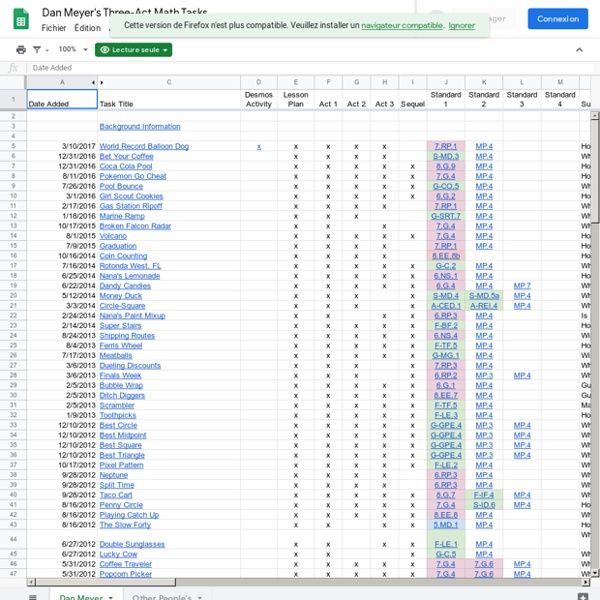



ALL STRANDS - Open-Ended Math Problems Open-Ended Math Problems This site is for the specific purpose of preparing Middle School students for OPEN-ENDED problem solving on standardized tests. We have divided each month into the five strands from the Philadelphia math standards:Number Theory Measurement Geometry Patterns, Algebra, and Functions Data, Statistics, and Probability There are three levels of difficulty for each standard. We have written and chosen problems from different sources that lend themselves to more than one way of solving. 3 Act Math – When Math Happens The 3 Act Math format was developed by Dan Meyer. See the links below. Explanation Post Modeled Lesson Dan’s Lessons 5 Practices Simple division - triangular jigsaw Numeracy: N1/L1.5, N1/L1.6 Level: L1 Resource type: Revision material, Tarsia jigsaw, Warm-up This 16 piece triangular jigsaw is a great way to revise or recap simple division. As usual with Tarsia puzzles, you can choose to print either a standard or large version of the puzzle (select Output – large, i.e. three pieces per A4 sheet).
Math Survey – Students I am taking Justin Lanier’s call to action from his talk “Beyond Beauty” at the Global Math Department. I posted over the weekend about the results of my survey of teachers and staff at my school. Today, I gave it to my students. Problem Solving - Potent Math Problems . . . are problems that have the potential to deepen understanding of significant mathematics through multiple answers approaches to an answer interpretations extensions perspectives on a mathematical idea layers of complexity algorithms Problems with multiple solutions and/or multiple approaches are often called open-ended problems, although many other problems also go by that name. Open and open-ended problems are frequently used in Japanese classrooms to achieve deep understanding of mathematical concepts. In American classrooms, they can be used effectively with teaching methods like the SPOSA model. Although we are developing a database of potent problems, we don't pretend that by themselves the problems will lead to deep understanding. The teacher counts.
Esti-Mysteries: Estimation Meets Math Mysteries - Steve Wyborney's Blog: I'm on a Learning Mission. Introducing Esti-Mysteries! Each image invites students to wonder what number is represented by the image. As you click through the each Esti-Mystery, clues will appear that will allow the students to use math concepts to narrow the set of possibilities to a small set of numbers. In the end, the students will need to call upon their estimation skills to solve the mystery and find the missing number.
Mr. B's Blog: I Volunteer as Tribute: The Final HSCN The arena set, the districts formed, the Capitol ready. Sounds like the beginning of the Hunger Games, doesn't it? This was the staging for the final HSCN: The Math Hunger Games. To bring you up to speed if you are not familiar with my HSCN, I hosted evenings three times a month where I instructed parents on math and reading. This is explored more in depth in this blog post. The final HSCN was Students vs. Probelm Solving - SPOSA The SPOSA model of teaching Larry Copes This is problem-based teaching in the sense that the mathematical ideas grow out of work on the problem, rather than proceeding work on the problem. Set the context. This step is often unnecessary.
common core resources /mathematical practice standards /standard 2: reason abstractly & quantitatively / classroom observations: Teachers who are developing students’ capacity to "reason abstractly and quantitatively" help their learners understand the relationships between problem scenarios and mathematical representation, as well as how the symbols represent strategies for solution. A middle childhood teacher might ask her students to reflect on what each number in a fraction represents as parts of a whole. A different middle childhood teacher might ask his students to discuss different sample operational strategies for a patterning problem, evaluating which is the most efficient and accurate means of finding a solution. Visit the video excerpts below to view these teachers engaging their students in abstract and quantitative reasoning.
How to Use Handwriting in Google Documents Earlier this week John Stevens tipped me off to using g(Math) to add handwritten responses to Google Forms. This morning John sent me a direct message on Twitter to tell me that you can now use handwriting in Google Documents through the g(Math) Add-on. John wrote out step-by-step directions with screenshots here. I made a short screencast of the process. That screencast is embedded below. Thanks again to John Stevens for the tip. The Three Acts Of A Mathematical Story 2016 Aug 6. Here is video of this task structure implemented with elementary students. 2013 May 14. A Guide to the 8 Mathematical Practice Standards Common Core mathematics is a way to approach teaching so that students develop a mathematical mindset and see math in the world around them. We are making problem-solvers. No matter what your objectives, textbook, or grade level, the eight mathematical practice standards are a guide to good math instruction. Here they are in plain English with suggestions for incorporating them into your everyday math class. #1 Make sense of problems and persevere in solving them What it means: Understand the problem, find a way to attack it, and work until it is done.
10 useful tools for assessment with tech Technology gives students lots of options for demonstrating their learning via assessments. Here are 10 tools to empower them. (Flickr / Brad Flickinger) We’re down to the final days of the school year at my school, and many students and teachers have turned their thoughts to assessment. Creative Math Problem Solving Please enable JavaScript to view this page content properly. Joy of Mathematical Problem Solving This website is a resource for anyone who wants to enjoy creative math problem solving.